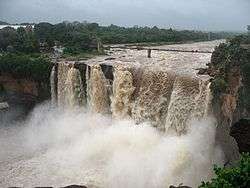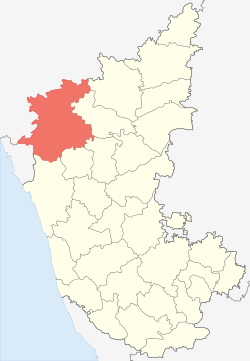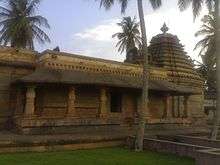Belgaum district
Belgaum is a district in the state of Karnataka, India. The district is known as Sugar Bowl of Karnataka with 1.5 lakh hectares being used for commercial production[2] and it has displaced Mandya district in sugar cane production over the last decade.[3]The city of Belgaum is the district headquarters in North Karnataka. It houses the second legislative building, where the Karnataka Legislature will meet once a year. According to the 2011 Census of India, it has a population of 4,779,661, of which 24.03% live in urban areas,[4] making it the second most populous district in Karnataka (out of 30), after Bangalore.[5] The district has an area of 13,415 square kilometers making it the largest district in Karnataka, and is bounded on the west and north by the state of Maharashtra, on the northeast by Bijapur District, on the east by Bagalkote District, on the southeast by Gadaga District, on the south by Dharawad District and Uttara Kannada districts, and on the southwest by the state of Goa.
Belgaum district | |
|---|---|
district | |
| Belagavi district | |
 Gokak Falls in Belgaum district | |
 Location in Karnataka, India | |
| Coordinates: 15.85°N 74.55°E | |
| Country | |
| Region | North Karnataka |
| Division | Belgaum division |
| Headquarters | Belgaum |
| Government | |
| • Deputy Commissioner | R. Vishal |
| Area | |
| • Total | 13,415 km2 (5,180 sq mi) |
| Population (2011)[1] | |
| • Total | 4,779,661 |
| • Density | 360/km2 (920/sq mi) |
| Languages | |
| • Official | Kannada |
| Time zone | UTC+5:30 (IST) |
| ISO 3166 code | IN-KA |
| Vehicle registration |
|
| Sex ratio | 1.04 ♂/♀ |
| Literacy | 64.2% |
| Precipitation | 823 millimetres (32.4 in) |
| Website | belgaum |
History

Belgaum is the Divisional Headquarters of North Karnataka. The original name of the town of Belgaum was Venugrama, meaning Bamboo Village. It is also known as Malnad Pradesh. The most ancient place in the district is Halsi; and this, according to inscriptions on copper plates discovered in its neighborhood, was once the capital of a dynasty of nine Kadamba kings. It appears that from the middle of the 6th century to about 760 the area was held by the Chalukyas, who were succeeded by the Rashtrakutas. After the break-up of the Rashtrakuta dynasty a portion of it survived in the Rattas (875–1250), who from 1210 onward made Venugrama their capital. Inscriptions give evidence of a long struggle between the Rattas and the Kadambas of Goa, who succeeded in the latter years of the 12th century in acquiring and holding part of the district. By 1208, however, the Kadambas had been overthrown by the Rattas, who in their turn succumbed to the Yadavas of Devagiri in 1250. After the overthrow of the Yadavas by the Delhi Sultanate (1320), Belgaum was for a short time under the rule of the latter; but only a few years later the part south of the Ghataprabha River was subject to the Hindu rajas of Vijayanagara. In 1347 the northern part was conquered by the Bahmani Sultanate, which in 1473 took the town of Belgaum and conquered the southern part also. When Aurangzeb overthrew the Bijapura sultans in 1686, Belgaum passed to the Mughals. In 1776 the country was overrun by Hyder Ali of Mysore, but was taken by the Madhavrao Peshwa with British assistance. In 1818 it was handed over to the British East India Company, and was made part of the district of Dharwar. In 1836 this was divided into two parts, the northern district becoming Belgaum.[6]
Yadur is situated beside the Krishna river, and there is a famous veerbhadra temple there. Many devotees visit the area from Karnataka and Maharashtra. Hooli is one of the oldest villages in Belgaum district. There are many Chalukya temples in the village, including the famous Panchaligeswara temple.
Kittur in Belgaum district is a place of historical importance. Rani Chennamma of Kittur (1778–1829) is known for her resistance to British rule.
The British had a sizable infantry post here, having realised the military importance of its geographic location. It is one of the reasons for Belgaum's sobriquet The Cradle of Infantry. Development of a rail network for the movement of resources and later troops was one of the means employed by both the British East India Company and the British to exert control over India. Belgaum's railway station, the Mahatma Gandhi Railway Station was established by the British. A signboard declaring the sobriquet can be seen hung on Platform 1 at the station.
Border dispute
Belgaum district was incorporated into the newly formed Mysore state (now Karnataka) with the passage of the States Reorganisation Act (1956), which reorganized India's states along linguistic lines since the majority of the people in the district spoke Kannada.
Administrative divisions
Administration of Belgaum District has been divided into 14 taluks. Athani taluk is the largest with an area of 1,997.70 km2 and Raybag taluk is the smallest with an area of 958.8 km2. The district comprises three revenue sub-divisions headquartered at Belgaum, Bailhongal and Chikodi which are headed by the Assistant commissioner and taluks headed by Tehsildar[7] and has six police sub-divisions. Apart from the Belgaum City Corporation, there are 17 municipalities, 20 towns, 485 gram panchayats, 1,138 inhabited villages and 26 non-inhabited villages. Belgaum is also the headquarters of the Belgaum Revenue Division.
Demographics
| Historical population | ||
|---|---|---|
| Year | Pop. | ±% p.a. |
| 1901 | 1,131,186 | — |
| 1911 | 1,083,804 | −0.43% |
| 1921 | 1,088,763 | +0.05% |
| 1931 | 1,237,223 | +1.29% |
| 1941 | 1,410,054 | +1.32% |
| 1951 | 1,645,620 | +1.56% |
| 1961 | 1,983,498 | +1.88% |
| 1971 | 2,422,994 | +2.02% |
| 1981 | 2,978,913 | +2.09% |
| 1991 | 3,583,606 | +1.87% |
| 2001 | 4,214,505 | +1.63% |
| 2011 | 4,779,661 | +1.27% |
| source:[8] | ||
According to the 2011 census Belgaum district has a population of 4,779,661,[5] roughly equal to the nation of Singapore[9] or the US state of Alabama.[10] This gives it a ranking of 25th in India (out of a total of 640).[5] The district has a population density of 356 inhabitants per square kilometre (920/sq mi) .[5] Its population growth rate over the decade 2001–2011 was 13.38%.[5] Belgaum has a sex ratio of 969 females for every 1000 males,[5] and a literacy rate of 73.94%.[5]
Education
Belgaum district is a home to 3 universities namely Visvesvaraya Technological University, Rani Channamma University, Belagavi and KLE University. Also, it has a 9 Engineering colleges, 2 Medical colleges, 2 Dental colleges, 15 Polytechnics, 7 Indian System of Medical colleges apart from 180 degree colleges in the district.[11]
Industry
The district has 7 Industrial Areas, 1 Special economic zone(which is India’s first precision engineering SEZ with more than 200 acres) and 16 Industrial Estates.[2] The city's humble industrial growth begin when an entrepreneur named Babu Rao Pusalkar set up a small unit in city over a century ago and that transformed Belgaum city into foundry and hydraulics base. Now, the city has a large number of crankshaft, industrial castings and forging, machinery, hydraulics, and aluminium manufacturing units.[12]
| Name of Industrial Area | Extent (acres) |
|---|---|
| Kanaburagi Auto Complex | 267.00 |
| Kakathi | 74.75 |
| Honaga | 209.5 |
| Kangrali | 58.59 |
| Gokak | 109.05 |
| Kittur | 433.19 |
| Kanagala | 848.00 |
| Name of Industrial Estate | Extent (acres) |
|---|---|
| Udayambag | 55.15 |
| Udayambag Tq. Karigarika Sangha | 0.32 |
| Anagol- 1 | 21 |
| Anagol- 2 | 4.6 |
| Kanabargi | 6 |
| Khanapur | 9.57 |
| Gokak | 9.62 |
| Chikkodi | 6 |
| Bailhongal | 3 |
| Ramdurg | 9.4 |
| Nippani | 3.5 |
| Kangrali | 2.5 |
| Desur | 41.34 |
| Athani | 28 |
| Borgao | 75 |
| Kagwad | 20 |
List of industrial clusters in Belgaum district that are identified by Ministry of Micro, Small and Medium Enterprises, Govt of India[13]
| Cluster place | Cluster activity |
|---|---|
| Belgaum | Foundry, Powerloom and artisan activities like Dolls & Toys,Horn & Bone, Metalware, Artistic Chappals by hand |
| Angol | Wooden Furniture Cluster |
| Udyambag | Machine Tool and Engineering Cluster |
| Kudachi | Kudchi Jaggery Cluster |
| Madhabavi | Foot Diamond Leather Cluster |
| Ramdurga | Readymade Garments Cluster,Birds Power loom Cluster |
| Chikkodi | Jaggery processing Cluster |
| Khanapura | Bricks Processing Cluster, Pottery & Clay, Terracotta, Textiles Hand Embroidered |
| Athani | Athani Raisins processing cluster |
| Gokak | Dolls & Toys |
Notable people
- S. Ballesh - Shehnai artist
- Hemant Birje - Actor
- Phadeppa Dareppa Chaugule - India's first Olympic marathon runner
- Kittur Chennamma - Indian freedom fighter
- Gangadharrao Deshpande - Indian Activist
- Kumar Gandharva - Indian classical singer
- Balappa Hukkeri- Singer
- Shamba Joshi - Writer
- Kaka Kalelkar (1885–1981) - Indian independence activist
- Chandrashekhara Kambara - Poet
- Basavaraj Kattimani - writer, novelist
- Laxmanrao Kirloskar - Indian businessman
- Betageri Krishnasharma - Writer
- Atul Kulkarni - Actor
- Shirasangi Lingaraj - Provincial ruler
- Panth Maharaj - Hindu Yogi
- Belawadi Mallamma - Warrior queen
- Ronit More - Cricketer plays for Chennai Super Kings
- Renukamma Murugodu - Actress
- Pramod Muthalik - The Chief of Sri Ram Sena
- Bandu Patil- Indian hockey player
- Sangolli Rayanna - Indian Freedom fighter
- Raja Lakhamagouda Sardesai - Ruler of Vantmuri princely state
- Acharya Shantisagar - Jain Digambara monk
- Acharya Vidyasagar - Jain Digambara monk
References
- "2001 Census". Official Website of Belgaum District. Archived from the original on 21 July 2011. Retrieved 4 January 2011.
- (PDF) https://kum.karnataka.gov.in/KUM/PDFS/DistrictProfile/Belagavi.pdf. Missing or empty
|title=(help) - "Karnataka elections: Meet the five brothers from Belagavi who are contesting against each other". Hindustan Times. 4 May 2018. Retrieved 19 January 2020.
- "Archived copy". Archived from the original on 11 January 2010. Retrieved 2009-08-27.CS1 maint: archived copy as title (link)
- "District Census 2011". Census2011.co.in. 2011. Retrieved 30 September 2011.
-

- "Sub Divisions and Talukas | District Belagavi , Government of Karnataka | India". Retrieved 18 January 2020.
- Decadal Variation In Population Since 1901
- US Directorate of Intelligence. "Country Comparison:Population". Retrieved 1 October 2011.
Singapore 4,740,737 July 2011 est.
- "2010 Resident Population Data". U. S. Census Bureau. Archived from the original on 19 October 2013. Retrieved 2011-09-30.
Alabama 4,779,736
- "Belagavi District". www.investkarnataka.co.in. Retrieved 13 December 2019.
- URS, ANIL. "Belagavi: A city on the frontlines reinvents itself". @businessline. Retrieved 14 December 2019.
- (PDF) http://dcmsme.gov.in/dips/state_wise_dips/state_profile_karnatka_11316.pdf. Retrieved 13 December 2019. Missing or empty
|title=(help)
External links
| Wikimedia Commons has media related to Belgaum district. |